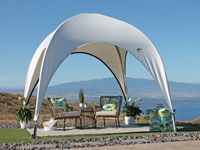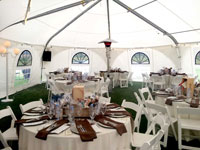Between growing student bodies and increasingly higher student-to-teacher ratios, there exists a great demand to quickly expand school buildings and provide additional classroom or learning space. This is comes on the heels of the Department of Education stating the following:
“Crowded classroom conditions not only make it difficult for students to concentrate on their lessons, but inevitably limit the amount of time teachers can spend on innovative teaching methods such as cooperative learning and group work or, indeed on teaching anything beyond the barest minimum of required material. In addition, because teachers must constantly struggle simply to maintain order in an overcrowded classroom, the likelihood increases that they will suffer from burnout earlier than might otherwise be the case.”
Modular classrooms made using portable trailers come with many unique challenges. While they give schools the ability to rapidly expand school campuses and provide additional learning space for a growing student body, the negative impacts of their use are far from desirable, and in some cases, even put children and teachers at risk.
The Growing Pains of Using Mobile Classroom Trailers
The term “portable classroom” is most often used to describe portable trailers. When schools and school leadership are not informed of the options available, they are likely to follow what other schools or school districts have done. This is called “piggy-backing” and is very commonly done by school districts considering the purchase of classroom trailers.
For an industry that is about teaching and imparting knowledge, little has been learned from the negative experiences of other schools that have made the choice of investing in portable classrooms. Perhaps it is a lack of funding that dictates such bad decisions, or an attempt to save time (and money) on determining portable classroom specifications and approvals by piggy-backing off another school district’s poor decision, or because schools, school boards, superintendents, as well other leadership need to be better informed of the available options to make an educated decision for quickly expanding school capacity and learning spaces.

Trailer classrooms are used as a low-cost alternative to the permanent construction of new or larger school buildings to combat overcrowding. Modular classrooms made from portable trailers are marketed as a great alternative for quick and temporary classrooms. It is under the umbrella of “temporary” that allows many companies to produce portable classrooms that do not meet the rigorous provisions of structural or building codes. In some states, regulatory ambiguity involving the construction and use of prefabricated classrooms doesn’t require securing portable classrooms to the ground – presenting a great risk to the health and safety of students and teachers. This is such a problem, the Environmental Protection Agency (EPA) has had to issue safety guidelines and checklists for schools in order maintain the safety of portable classrooms.
While their certainly exists a range in quality of portable classrooms, the construction of most trailer classrooms is very similar. Cheaply laminated walls, floors, and ceilings provide an expected and unimpressive level of interior aesthetic. Exterior finishes are typically panelized siding, the most economical windows and roofing materials available, mounted to a wood frame that can be trailered in, and set onto a temporary foundation, like concrete cinder blocks. Nothing about portable classrooms made from trailer solutions convey a sense of indoor environmental quality, natural resource conservation, energy efficiency, or providing a healthy and safe learning environment.
Most trailer classrooms are designed for short periods of use – as temporary classrooms but are actually used much beyond their intended life span, in some cases for decades, and once installed are very rarely ever moved! The prolonged use of trailers for portable classrooms results in poorly functioning HVAC systems which provide minimal ventilation with outside air. The lack of ventilation spurs the rapid growth of mold. Additionally, trailer classrooms are well known for having poor acoustics. Noises from loud ventilation systems, busy roads, as well as noises from equipment during school construction or expansion projects can be distracting to students. This is especially true for ESL, special education, or reading intervention classes. Chemical off-gassing from high-emission materials (noted above) can cause severe or acute health complications for students and teachers.
In Utah, the two largest school districts (Alpine and Davis County) use 710 portable classrooms – housing roughly 30,000 children a day! Civil and structural engineer groups have issued warning statements declaring the anchoring methods for most portable classrooms are unsafe and are pressing for the consideration of portable classrooms used for more than 180 days be deemed permanent school buildings and be required to meet building codes.
The prolonged and continued use of trailers for portable classrooms reflects poorly on the school and the leadership’s ability to propose a temporary classroom solution and stick to a predetermined replacement schedule or being knowledgeable and investing in higher performance school buildings.
Modular Classrooms Using Engineered Fabric Structures
If only there was a solution that could provide schools with a temporary and / or long-term permanent classroom expansion option, that meets the design guidelines for creating a bright and positive learning environment, as well as providing a classroom building solution that is engineered to meet stringent building codes, can be safely anchored to almost any surface or ground type, and is capable of being installed in a fraction of the time compared to permanent school buildings using conventional construction methods? There is!
Expertly engineered school buildings and modular classroom from Alaska Structures provide a superior option for schools and school districts needing to quickly meet the demands of school expansion and growing classrooms.
Tensioned fabric buildings have been around for some time. Their use is diverse – fulfilling the building needs of many industries including rapidly deployable medical facilities capable of quickly responding to natural disasters around the world, to large warehouses, equipment storage facilities, fabrication shops, maintenance facilities, dry-dock enclosures, portable camps for remoting mining, oil and gas, as well as construction projects …to name a few.
While there are many fabric building companies out there, few truly design and engineer building systems to meet stringent building code requirements. Alaska Structures is known for taking on projects that require extreme levels of engineering – designing buildings for the base camp of Mt. Everest – capable of withstanding the jet-stream winds and avalanches at a mind staggering elevation of 17,500 feet. Or providing more than 30,000 military shelter systems to U.S. and Coalition Forces specifically designed for rapid setup / strike operations and capable of enduring the blistering heat and sand storms of the Middle East.

To say the team at Alaska Structures goes to great lengths to ensure the durability and safety of their building systems – would be a complete understatement. A tour of their modular classroom system, as well as the 325,000 square foot production facility in Las Cruces, New Mexico will leave you in complete awe. Combine this with their nearly 50 years of proven excellence, and their claim of unmatched capability as the world’s leading provider of engineered fabric building systems is easy to understand.
Alaska Structures engineer superior alternatives to conventional classrooms with the use of fabric buildings.
Alaska Structures engineers fabric structures to support educational facilities:
- Low life cycle cost.
- Designed for permanent or temporary use.
- Energy efficient design (meets latest state energy codes).
- Benefits over traditional modular classroom buildings include:
- Spacious open ceiling design.
- Central utility room.
- Fabric colors available to match school colors.
- School logos on each building.
- Easy to dismantle and move to next location. Can be relocated multiple times without damage to the building.
- Quick delivery
- Installation included in price. Enjoy peace of mind, knowing your modular building will be setup quickly with an experienced setup team from Alaska Structures!
To discuss your upcoming school expansion or modular classroom needs, please call Alaska Structures at +1-907-344-1565.

















































































Leave a Reply